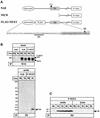Presenilins mediate a dual intramembranous gamma-secretase cleavage of Notch-1
- PMID: 12374741
- PMCID: PMC129073
- DOI: 10.1093/emboj/cdf541
Presenilins mediate a dual intramembranous gamma-secretase cleavage of Notch-1
Abstract
Following ectodomain shedding, Notch-1 undergoes presenilin (PS)-dependent constitutive intramembranous endoproteolysis at site-3. This cleavage is similar to the PS-dependent gamma-secretase cleavage of the beta-amyloid precursor protein (betaAPP). However, topological differences in cleavage resulting in amyloid beta-peptide (Abeta) or the Notch-1 intracellular domain (NICD) indicated independent mechanisms of proteolytic cleavage. We now demonstrate the secretion of an N-terminal Notch-1 Abeta-like fragment (Nbeta). Analysis of Nbeta by MALDI-TOF MS revealed that Nbeta is cleaved at a novel site (site-4, S4) near the middle of the transmembrane domain. Like the corresponding cleavage of betaAPP at position 40 and 42 of the Abeta domain, S4 cleavage is PS dependent. The precision of this cleavage is affected by familial Alzheimer's disease-associated PS1 mutations similar to the pathological endoproteolysis of betaAPP. Considering these similarities between intramembranous processing of Notch and betaAPP, we conclude that these proteins are cleaved by a common mechanism utilizing the same protease, i.e. PS/gamma-secretase.
Figures





Similar articles
-
Genes and mechanisms involved in beta-amyloid generation and Alzheimer's disease.Eur Arch Psychiatry Clin Neurosci. 1999;249(6):266-70. doi: 10.1007/s004060050098. Eur Arch Psychiatry Clin Neurosci. 1999. PMID: 10653281 Review.
-
Presenilin-dependent intramembrane proteolysis of CD44 leads to the liberation of its intracellular domain and the secretion of an Abeta-like peptide.J Biol Chem. 2002 Nov 22;277(47):44754-9. doi: 10.1074/jbc.M206872200. Epub 2002 Sep 9. J Biol Chem. 2002. PMID: 12223485
-
Requirement for presenilin 1 in facilitating lagged 2-mediated endoproteolysis and signaling of notch 1.J Mol Neurosci. 2000 Dec;15(3):189-204. doi: 10.1385/jmn:15:3:189. J Mol Neurosci. 2000. PMID: 11303783
-
Two transmembrane aspartates in presenilin-1 required for presenilin endoproteolysis and gamma-secretase activity.Nature. 1999 Apr 8;398(6727):513-7. doi: 10.1038/19077. Nature. 1999. PMID: 10206644
-
Role of presenilin in gamma-secretase cleavage of amyloid precursor protein.Exp Gerontol. 2000 Jul;35(4):453-60. doi: 10.1016/s0531-5565(00)00111-x. Exp Gerontol. 2000. PMID: 10959033 Review.
Cited by
-
Take five--BACE and the gamma-secretase quartet conduct Alzheimer's amyloid beta-peptide generation.EMBO J. 2004 Feb 11;23(3):483-8. doi: 10.1038/sj.emboj.7600061. Epub 2004 Jan 29. EMBO J. 2004. PMID: 14749724 Free PMC article. Review.
-
Regulation of Notch signaling by dynamic changes in the precision of S3 cleavage of Notch-1.Mol Cell Biol. 2008 Jan;28(1):165-76. doi: 10.1128/MCB.00863-07. Epub 2007 Oct 29. Mol Cell Biol. 2008. PMID: 17967888 Free PMC article.
-
Changes in gamma-secretase activity and specificity caused by the introduction of consensus aspartyl protease active motif in Presenilin 1.Mol Neurodegener. 2008 May 12;3:6. doi: 10.1186/1750-1326-3-6. Mol Neurodegener. 2008. PMID: 18474109 Free PMC article.
-
Soluble oligomers of the intramembrane serine protease YqgP are catalytically active in the absence of detergents.Biochemistry. 2008 Nov 18;47(46):11920-9. doi: 10.1021/bi800385r. Epub 2008 Oct 21. Biochemistry. 2008. PMID: 18937501 Free PMC article.
-
Dual cleavage of neuregulin 1 type III by BACE1 and ADAM17 liberates its EGF-like domain and allows paracrine signaling.J Neurosci. 2013 May 1;33(18):7856-69. doi: 10.1523/JNEUROSCI.3372-12.2013. J Neurosci. 2013. PMID: 23637177 Free PMC article.
References
-
- Beher D., Wrigley,J.D., Nadin,A., Evin,G., Masters,C.L., Harrison,T., Castro,J.L. and Shearman,M.S. (2001) Pharmacological knock-down of the presenilin 1 heterodimer by a novel γ-secretase inhibitor: implications for presenilin biology. J. Biol. Chem., 276, 45394–45402. - PubMed
-
- Brou C. et al. (2000) A novel proteolytic cleavage involved in Notch signaling: the role of the disintegrin-metalloprotease TACE. Mol. Cell, 5, 207–216. - PubMed
-
- Cao X. and Sudhof,T.C. (2001) A transcriptionally active complex of APP with Fe65 and histone acetyltransferase Tip60. Science, 293, 115–120. - PubMed
-
- Capell A., Steiner,H., Romig,H., Keck,S., Baader,M., Grim,M.G., Baumeister,R. and Haass,C. (2000) Presenilin-1 differentially facilitates endoproteolysis of the β-amyloid precursor protein and Notch. Nat. Cell Biol., 2, 205–211. - PubMed
-
- Chung H.M. and Struhl,G. (2001) Nicastrin is required for presenilin-mediated transmembrane cleavage in Drosophila. Nat. Cell Biol., 3, 1129–1132. - PubMed
Publication types
MeSH terms
Substances
LinkOut - more resources
Full Text Sources
Other Literature Sources
Molecular Biology Databases

